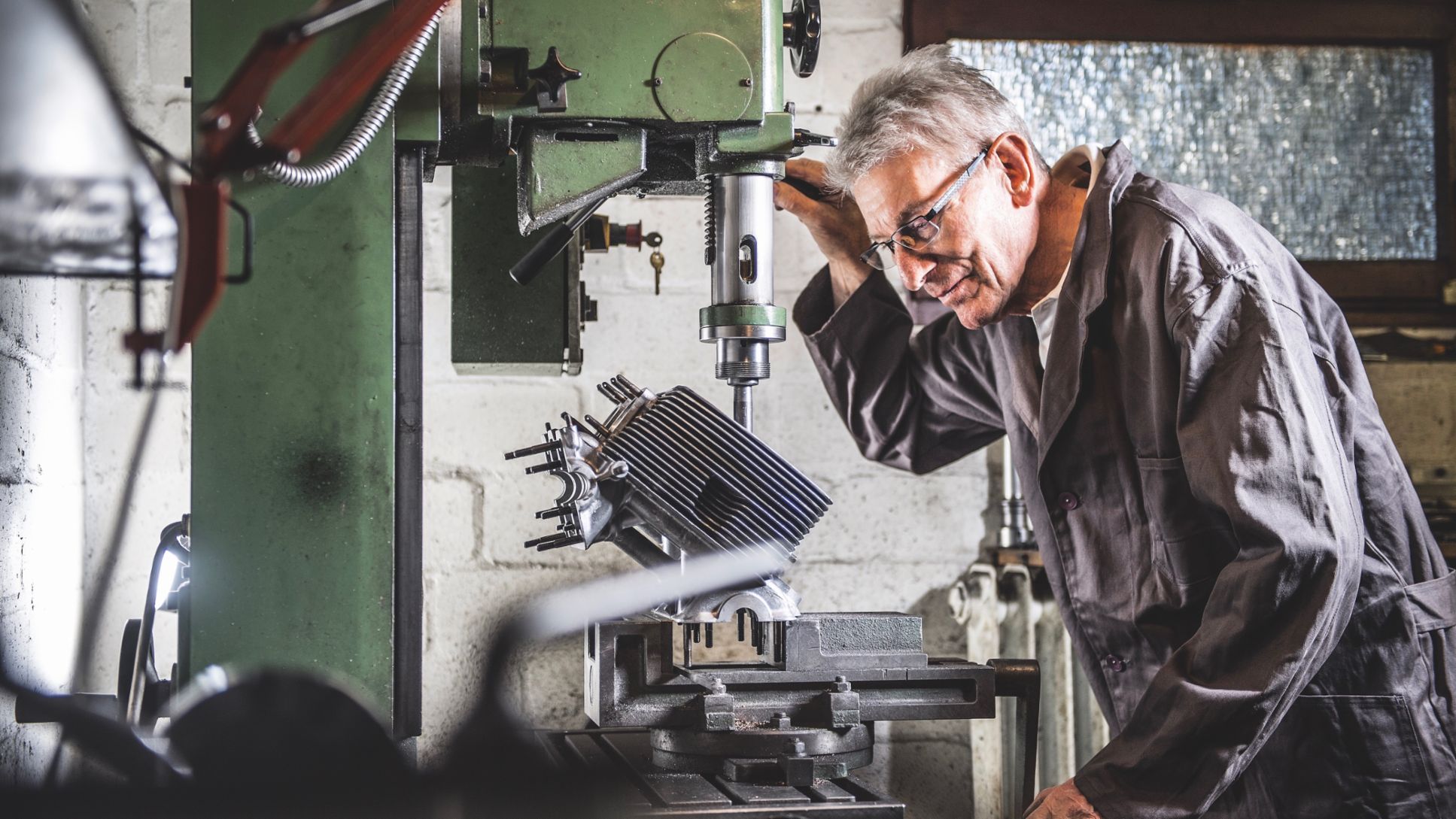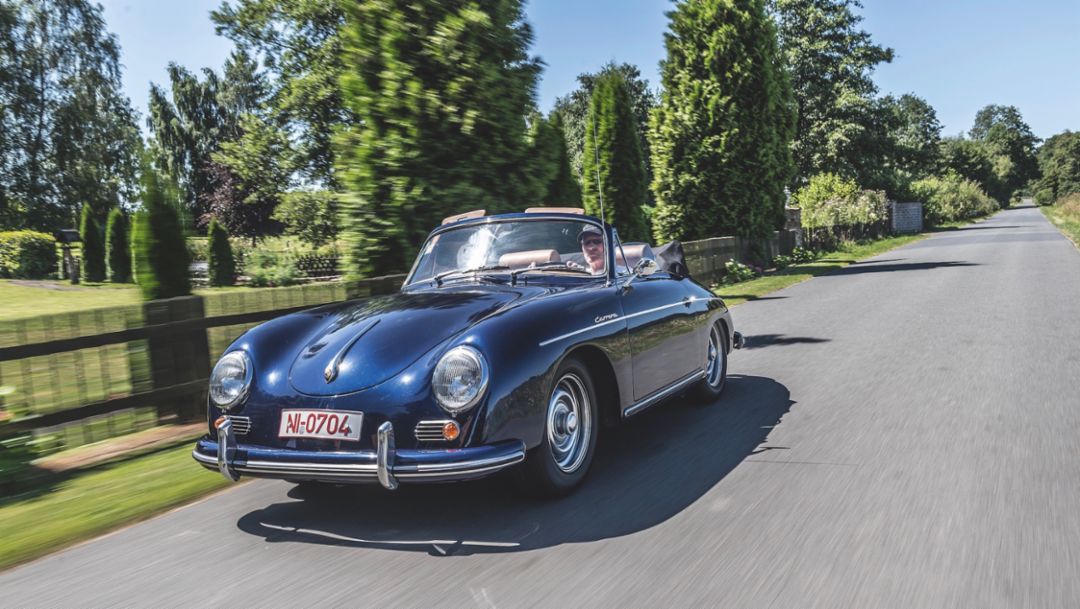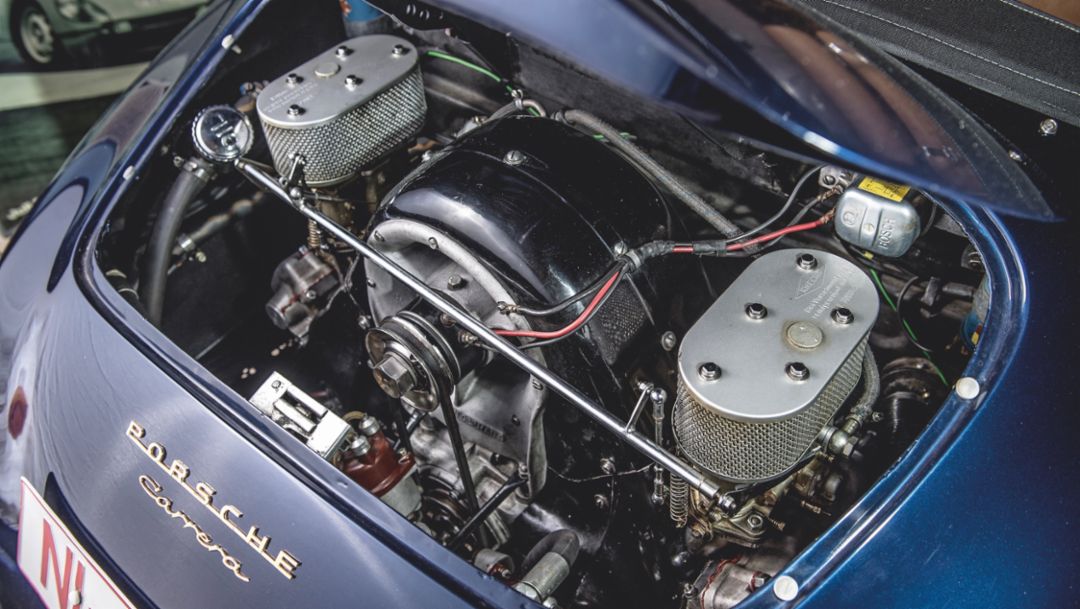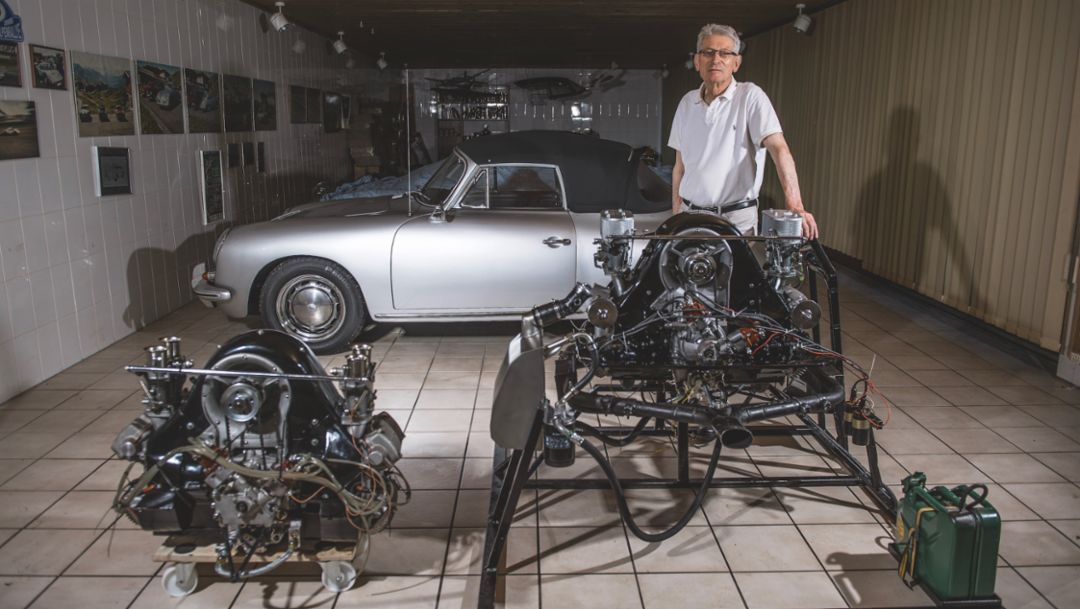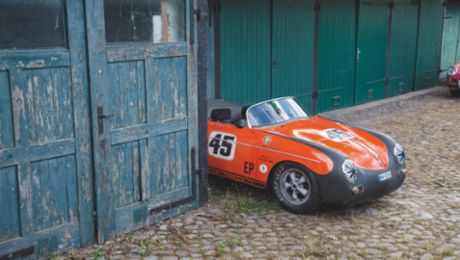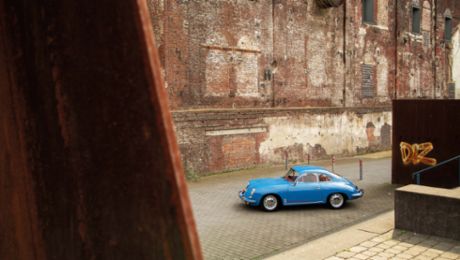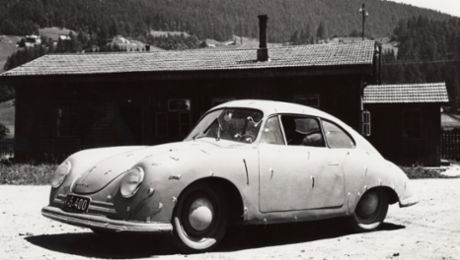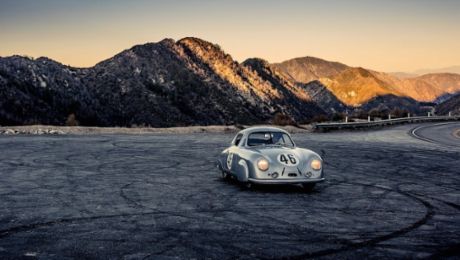“I’m fascinated by the complex technology.” The words have barely left the mouth of the tall lean man in a white polo shirt before he expertly presses a number of buttons on the engine stand he has built himself. Within moments, an ear-shattering racket puts an end to the peace and quiet of the morning. We’re in a residential district somewhere in Lower Saxony, where the streets are lined with detached homes. It’s the kind of place where you’ll get frowned at if you don’t mow your lawn, where blackbirds tweet away happily and where local shooting clubs recruit new members. Peter Pohl, a passionate tinkerer and probably the world’s leading expert on the legendary vertical shaft engine, lives in the midst of this suburban idyll.
And it’s one of these Porsche engines, housed in Pohl’s garden shed, which is currently rattling our eardrums. Pohl grins happily. It took him two years to gather all the individual parts he needed. And he’s spent over 200 hours working on this exceptional engine. “I’ve become genuinely fond of this engine – after all, I built it myself.” Even though fewer than 2,000 vertical shaft motors were ever produced, four of them are lined up in Pohl’s garden shed. As well as the one which is idling away stertorously, a 904 replacement engine with powerful Weber IDA carburettors is awaiting its turn on a creeper. Another is installed in a bright red Porsche 356 B 2000 GS/GT. “Only around 15 of these vehicles were ever built.” The racing 356 with a pared-down weight achieves “a good 200 hp” after undergoing treatment at Pohl’s automotive hospital – the series production vehicles managed a maximum of 155 hp. Pohl has a collection of valuable high-calibre sports cars, but his favourite is a blue 356 A Cabriolet - a 1600 GS Carrera.
The vertical shaft engine was produced by Porsche in small numbers, but was all the more significant in terms of the marque’s reputation because it paved the way from the Beetle engine towards a racing engine. More than any other engine, the four-cylinder flat engine of the 547 and its stablemates, the 587 and 692, therefore underpins the mythology of the Porsche marque. The engine was developed by the former Porsche engineer Prof. Dr.-Ing. Ernst Fuhrmann in 1952, with an innovative valve drive which allowed drivers to reach astonishing speeds. The engine is characterised by two overhead camshafts per cylinder bank, controlled via shafts with angular gears – the eponymous vertical shafts – based on Fuhrmann’s ingenious design.
The “Fuhrmann engine”, as the mechanical masterpiece was known, put Porsche on the racing podium countless times. For example, the legendary double victory by Frère/Frankenberg and Herrmann/Glöckler at the 24 Hours of Le Mans in 1953 was only possible thanks to the new engine in the Porsche 550 Spyder. Porsche customers who were lucky enough to get behind the steering wheel of one of the 356 derivatives powered by a Fuhrmann engine (bearing the prestigious Carrera logo) could explore whole new worlds in terms of driving dynamics. For example, the 1500 GS Carrera delivered a superb output of 100 hp instead of the 75 hp achieved by the previous flagship model (the 1600 S). The Fuhrmann engine in the Porsche 904 (Carrera GTS), which had been enlarged to 2 litres, even produced a mighty 185 hp.
In his workshop, Pohl has breathed fresh life into countless vertical shaft motors; at the same time increasing their power and stability. The casting engineer is a self-taught expert in the field. How did he acquire this knowledge? Way back in the 1960s, the Porsche 356 was Peter Pohl’s car of choice, but as a young engineer he could only afford models with push-rod engines. In 1984, his dream of owning a Carrera came true when he acquired a right-hand drive Carrera 2, which he raced in historic motor sports events. All was not well, however: “Any 356 with a small 1.6-litre push-rod engine could overtake me on the straights” – and that just wasn’t good enough. Pohl, who has dissected and tinkered with engines all his life, did not hesitate to disassemble the complex “king of flat engines” in order to restore its previous vigour.
It was followed by other vertical shaft assemblies, from his own vehicles and those of his friends. Pohl has amassed an invaluable amount of knowledge on how to overhaul and optimise these engines over the past 30 years; after all, “the Carrera engines weren’t running entirely smoothly even when they passed the factory gates”. Using the lathe and milling machine in his home workshop, he manufactures lighter valves from modern blanks, adapts various cams and drills oil relief holes into the vertical shafts, which mitigates the tendency of the engine to leak.
A book for amateur engine builders
Pohl has now condensed all of his theoretical and practical knowledge into a 108-page book entitled “Die Vierzylinder-Königswellenmotore von Porsche [Porsche four-cylinder vertical shaft engines]”, available directly from the author (u_p.pohl@t-online.de; 98 euro). This highly informative book is illustrated with countless diagrams and drawings, which are a huge help in understanding the subject matter. As well as describing the various engines and the Porsche types they powered, Pohl dwells separately on each of the components in a vertical shaft engine. The centrepiece of the book is, however, the chapter entitled “Practical instructions for overhauling an engine”, which teaches keen amateur engine builders everything they need to know from disassembly and testing through to assembly, tuning and running in of the Carrera engine.
With admirable thought for the convenience of users, another copy of this chapter is included as a workshop manual, to avoid the book getting covered in oily fingerprints. A chapter on improving performance and practical tips on the operation of the Fuhrmann engine round off this highly recommended book. Pohl explains why he finds these pieces of machinery so fascinating: “You can only keep an engine like this running if you know your stuff and work with extreme care.” For example, the plain bearing of the intermediate shafts has zero clearance at room temperature. The expert explains that the Fuhrmann engine is not frost-proof and may jam at low temperatures owing to the differing expansion rates of the metals used. Many 356 Carrera vehicles therefore underwent heart surgery to remove their vertical shaft engines and make them more usable on a day-to-day basis.
This is precisely what happened to Pohl’s blue A-model Cabriolet, which was fitted with a Beetle engine when he bought it in the late 1980s. Unable to find a suitable Carrera engine, Pohl produced design sketches for the engine block and heads, and was able to persuade Porsche to carry out the small reproduction job. During the test drive scheduled for today, the driving skills of our 81-year-old chauffeur are no less impressive than the youthful vigour of the engine which was built using these parts and which has so far driven 65,000 kilometres. During the trip, Pohl regales his passengers with anecdotes and interesting facts about his favourite engine. His top tip for preserving engines in racing cars: “Drive the thing and then drive it some more! An engine’s far more likely to fail if it stands around doing nothing for long periods than if it regularly gets a decent run.”
After returning to Pohl’s garden shed, I ask him how much he would charge for the freshly assembled flat engine on the engine stand. The 81-year-old smiles, but does not answer my question. He tells me that he built the engine for a good friend, and that it’s the last of its kind – Pohl’s days of assembling complete engines are over. And then he adds, betraying a note of hope in his voice: “If my friend decides he doesn’t want it, I’ll put it in my living room.”
Info
Text first published in the magazine "Porsche Klassik 12".
Text by Arne Olerth // Photos by Jan Bürgermeister
Copyright: The image and sound published here is copyright by Dr. Ing. h.c. F. Porsche AG, Germany or other individuals. It is not to be reproduced wholly or in part without prior written permission of Dr. Ing. h.c. F. Porsche AG. Please contact newsroom@porsche.com for further information.
